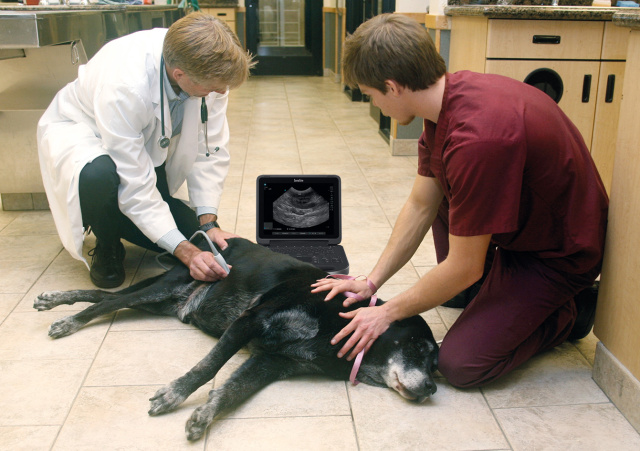
Veterinary surgeons have recognized the benefits of point-of-care ultrasound for decades and they value how its use in large and small animal medicine informs diagnosis and minimizes surgical intervention. Beresford Capps, a veterinary surgeon based in Lewisham, South East London, describes the difference it makes to his own small animal practice, and to the care of larger animals on his farm in the Ashdown Forest, East Sussex.
I am the senior partner in a veterinary practice that has existed in Lewisham for over half a century. We provide the highest standards of expert care for pets, and advice to their owners, using state-of-the-art facilities in our modest premises in the heart of the borough. While relatively small, the practice has fully equipped preparation and operating facilities, an in-house laboratory for rapid results, and diagnostic equipment including X-ray, ultrasound, and echocardiogram machines.
Performing and interpreting ultrasound investigations was included in my initial training at veterinary college in the early 1990s and I began using it regularly from 1997, firstly in equine practice. For the last 18 years, since acquiring the practice in Lewisham, I have specialized in companion animal medicine and use FUJIFILM Sonosite point-of-care ultrasound (POCUS) on a frequent basis with the cats and dogs that are brought into the practice. Common reasons to scan a pet might be to diagnose or monitor kidney or liver disease, investigate abdominal symptoms, or explore heart problems. The information ultrasound provides is invaluable for these investigations and enables us to identify a problem and plan management there and then or, in many cases, simply reassure the owner there is nothing to worry about.
I find it particularly useful for investigating masses – a foreign body may be present in a cystic structure, for example – or, if it is a solid mass, the information gleaned from a scan is invaluable before treating surgically. I always use POCUS when taking biopsies, often from several sites, and this reduces the need for a full surgical exploratory procedure. If surgery is necessary, using ultrasound to guide the procedure can significantly reduce the overall duration of the operation, resulting in less time under general anaesthetic and a quicker recovery time for the pet. In our practice, we have used FUJIFILM Sonosite ultrasound machines since 2005; it took many years for me to abandon my old system as it did a good job and just kept on going – however, I was amazed at the quality of the images available with the Sonosite Edge II, which I use now.The system was just as intuitive, and it has many additional measuring functions built in; I no longer need to disconnect probes when swapping to a different one, we can switch between three probes at the touch of a button and the speed of all its functions is much quicker. I am really glad that the innovations in technology haven’t compromised the portability or robustness of the machine; equipment used in veterinary medicine needs to be extremely tough to withstand potential knocks and it has to function well in all environments.
I have the perfect opportunity to test this out on a regular basis, away from the practice’s urban environment, as I live on a farm in Ashdown Forest, East Sussex, and look after the cows and horses we have there. If I know one of them needs extra attention, I can take the ultrasound machine to the farm and examine the animal there and then; we might need to confirm a pregnancy or inspect lameness, for example. It certainly saves a lot of time, worry, and expense when decisions can then be made based on up-to-date, accurate information – all available to me in a muddy cow-shed!
When I recently needed to upgrade my ultrasound machine, I dealt with FUJIFILM Sonosite directly as they were able to give me the most competitive rates by far – crucial to a small practice like mine. The whole experience was very straightforward and efficient, not only in providing and installing the machine, but in training myself and the other vet in the practice, and in rectifying a probe issue within 24 hours. The individuals I have had contact with have been outstanding; they are clearly very knowledgeable about their products but also seem to genuinely love working for Sonosite, which I think speaks volumes about a company.
Considering my dependence on POCUS and the benefits it brings to my work and homelife, I don’t think I could manage without it. It allows me to take the best care of larger animals on the farm and to provide in-house assessment and treatments in Lewisham, instead of owners having the additional travel and expense of management elsewhere. This also improves the income for my small practice and the animals do not go through unnecessary explorative procedures like they did in the past. I believe it is a win-win situation for myself, the owners, and of course their beloved pets.
Discover the Sonosite Edge II
Designed to be truly portable and used in the most rugged environments, the Sonosite Edge II reinforces our commitment to reliability and durability with Armored Cable Technology. With an embedded metal jacket, armored cables protect transducers from common abuse accident scenarios, like being rolled over, stepped on, or twisted, and help maintain image quality over the life of transducers built on this cable platform.

